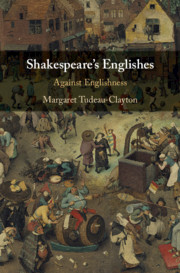Book contents
- Shakespeare’s Englishes
- Shakespeare’s Englishes
- Copyright page
- Epigraph
- Contents
- Table and Illustrations
- Acknowledgements
- Chapter 1 Introduction
- Chapter 2 Shakespeare and ‘the King’s English’
- Chapter 3 Shakespeare and ‘the true-born Englishman’
- Chapter 4 ‘they bring in straing rootes’
- Chapter 5 Figures and Parables of a ‘straing’ Word
- Bibliography
- Index
Chapter 2 - Shakespeare and ‘the King’s English’
Language, History, Power
Published online by Cambridge University Press: 07 October 2019
- Shakespeare’s Englishes
- Shakespeare’s Englishes
- Copyright page
- Epigraph
- Contents
- Table and Illustrations
- Acknowledgements
- Chapter 1 Introduction
- Chapter 2 Shakespeare and ‘the King’s English’
- Chapter 3 Shakespeare and ‘the true-born Englishman’
- Chapter 4 ‘they bring in straing rootes’
- Chapter 5 Figures and Parables of a ‘straing’ Word
- Bibliography
- Index
Summary
This chapter provides a history of ‘the King’s English’ as a context for an analysis of language, history and power in The Merry Wives of Windsor and the second tetralogy. The trope is used as a rhetorical and ideological tool in performatives. Associated with temperance and honesty, ‘the King’s English’ belongs to a set of defining values of true Englishness. The project to produce this linguistic norm coincides with a homologous project to produce a stable, monetary system of ‘good’ coin through exclusion of ‘bad’, ‘counterfeit’ or ‘clipped’ coin. These projects testify to a shift of the centre of economic and cultural gravity from the court to the merchant citizen class. Shakespeare’s one English comedy centred on English citizens which features his one use of ‘the King’s English’ is shown to engage critically with this ideology, and to set against it an idea of ‘our English’ as an inclusive mix, the ‘gallimaufry’ loved by the linguistically extravagant gentleman John Falstaff. The comedy draws out the implications of the banishment of Falstaff in the second tetralogy, which sets history against the project of cultural reformation ideology to produce (the) ‘true’ English.
Keywords
- Type
- Chapter
- Information
- Shakespeare's EnglishesAgainst Englishness, pp. 46 - 92Publisher: Cambridge University PressPrint publication year: 2019



